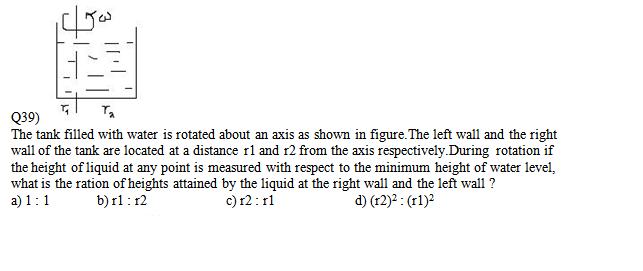I had thot it wud b sumthing related 2 centrifugal force = mR1w2 and mr2w^2 [2]

SOLUTION :
39 (d) y = ω2r2/2g , measured from the axis of the parabola.
CAN sum1 pl. help me decipher,
1) how did this expression cum ??? [7]
2) wats the parabola, wich is being talked abt??
-
UP 0 DOWN 0 1 12

12 Answers
take a particle sumwhere inbeteen on the surface of the liquid ,,,,,,,,,
the forces actin are.......
g downward....
w2x away frm axis .....[takin particle x m frm axis] ........
now if i take the tan of the angle between the net accn and vertical ..[perp to net accn will be tangent to surface which is parabolic].........
w2x/g = tan @ = dy/dx ...
w2x2/2g = y ......
y is height and x is distance frm axis........
so if we take distances as r1,r2 we can see ratio of heights will be r12/r22
hope it was useful!!!!
telme if u didnt understand!!!!!!!
lovely solution DUDE, thnx yaar!!
wait i'll post ek aur questn HA hA
lets divide spring into various segments of length dx and let a segment be at distance x frm fixed end...........
now clearly velocity of each segment is x/L(v0) [ assuming a linear velocity gradient]
dm = dxM/L [ASSUMING UNIFORM DENSITY[ .........
∫1/2dmv2 = net KE of spriing ...
∫1/2(dx/L * M)(x/L*V0)2 ..
=1/6MV02
KE OF BLOCK IS CLEARLY 1/2mV02
now
COME
1/2mV02 + 1/6MV0^2 = 1/2KX2 ...
SOLVIN I THINK ULL GET C ONLY!!!!
UR SOLTN IS BINGO!!!
HMMMM... GTO MA MIST. ....
BUT HEY Y DO V ASSUME LINEAR VEL. GRADIENT?
KYA IDEAL CASE MEIN AISA HOTA HAI??
SORRY FOR LATE REPLY WAZ WACHIN GAJINI.........[3]
YEP U JUST LUK AT THE BEHAVIOR OF VELOCITY ..........AT THE END ITS SAME AS TH BLOCK..V0..AT THE FIXED END ITS ZERO... THEN U CAn formulate it
hmmm pt. but then it cud also be v=v0sin(wt) or sumthin like dat.... ????
no point arguin coz it must b a convention.......
so can u tell me 4 sure dat v assume uniform vel grad. wen its givn???
YEP. IM QUITE SURE... KAHAN SE ""wt"" AA GAYA v is a funtion of x .......it is assumed unlees informed dat it linear variation
